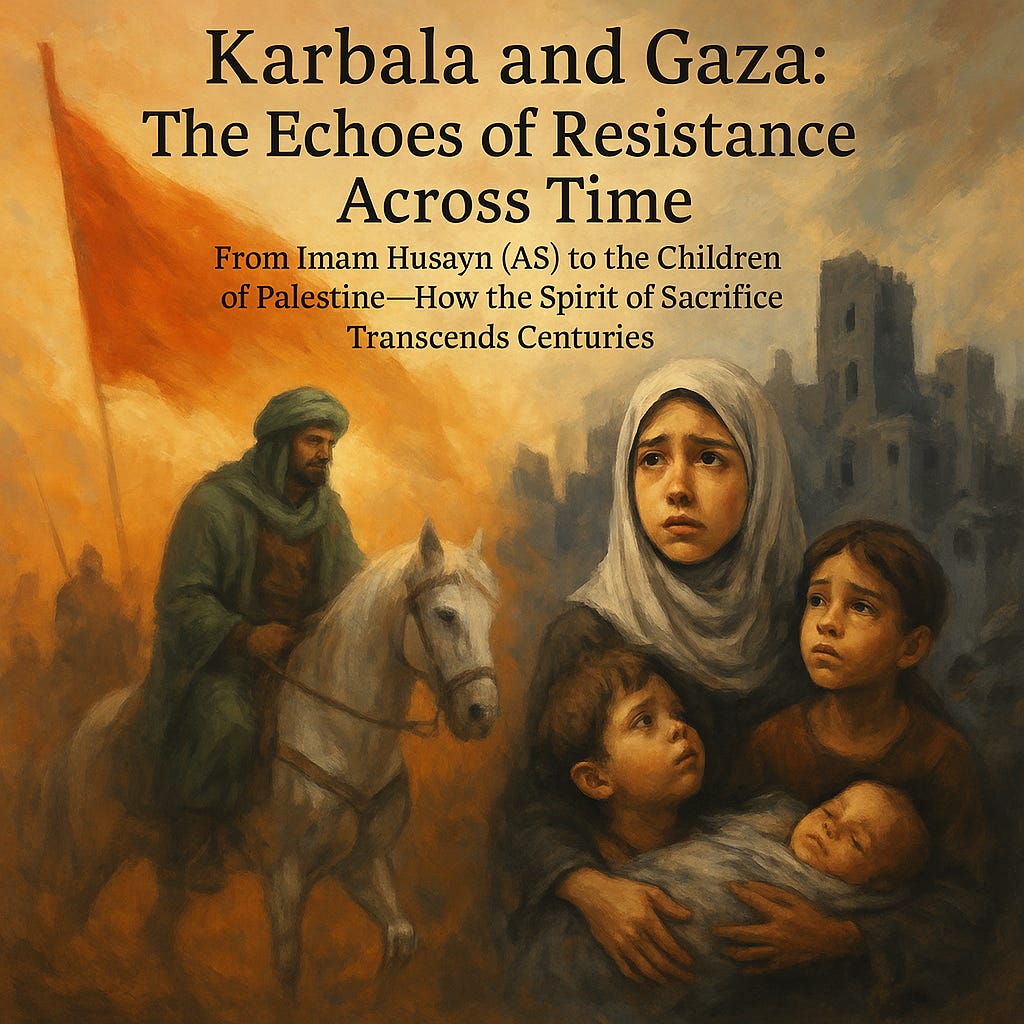Karbala and Gaza: The Echoes of Resistance Across Time
From Imam Husayn (AS) to the Children of Palestine—How the Spirit of Sacrifice Transcends Centuries
Introduction: The Timeless Cry of “Is There Anyone to Help Us?”
The land of Karbala witnessed an unmatched tragedy in 680 AD when Imam Husayn ibn Ali (AS), the grandson of the Prophet Muhammad (S), stood against tyranny and injustice. Though outnumbered and betrayed, he refused to give allegiance to a corrupt regime, choosing martyrdom over submission. More than 1,300 years later, the same cry for justice reverberates through the streets of Gaza, where men, women, and children resist occupation, siege, and systematic oppression.
Though separated by time and geography, the parallels between Karbala and Gaza are deeply striking. Both are stories of unwavering resistance in the face of overwhelming odds. Both expose the hypocrisy of those who claim peace but inflict war. And both reveal the enduring power of faith, courage, and sacrifice.
1. The Battle Against Oppression: Yazid Then, Zionism Now
Imam Husayn (AS) rose against Yazid not to seek power, but to preserve the moral fabric of Islam. Yazid symbolised the corruption of religion, the suppression of truth, and the silencing of the oppressed. Similarly, the Palestinian resistance today faces an apartheid regime backed by global powers, fuelled by a sense of entitlement and impunity. Gaza, like Karbala, stands as a symbol of refusal to bow before injustice.
2. Siege, Starvation, and the Weaponisation of Thirst
In Karbala, the army of Yazid blocked access to water for Imam Husayn (AS) and his family for three brutal days under the scorching sun. This was not just physical cruelty—it was psychological warfare. Today, in Gaza, the siege continues to choke life: water supplies are cut, electricity is limited, medicine is blocked, and food is rationed. The same cruelty has evolved in form, but not in essence.
3. Children of Resistance: From Ali Asghar to the Martyrs of Gaza
The image of the infant Ali Asghar (AS), struck by an arrow in the arms of his father on the plains of Karbala, evokes a grief that echoes in every child martyred in Gaza. The children of Gaza, like the children of Karbala, are not passive victims—they are symbols. Symbols of the cruelty of the aggressors and the innocence of the cause. Their blood becomes the ink that writes the history of resistance.
4. Women as Pillars of Truth: From Zainab (SA) to the Mothers of Gaza
Lady Zainab (SA), the sister of Imam Husayn (AS), was taken captive and paraded in Damascus, yet she stood firm and spoke truth to power. She carried the message of Karbala beyond the battlefield. Today, the mothers, sisters, and daughters of Gaza stand as powerful witnesses to injustice. Their tears, like Zainab’s words, are not signs of weakness but of resolve. They raise their voices to the world, reminding humanity of its duty to act.
5. Media Narratives and the Battle for Truth
Just as the Umayyads tried to distort the story of Karbala, today’s mainstream media often fails to represent the reality of Gaza. The narrative is manipulated to blame the victim and excuse the oppressor. But just as Karbala’s truth survived through the sermons of the Ahl al-Bayt (AS) and the hearts of the faithful, so too does Gaza’s story endure through independent voices, grassroots activism, and the conscience of the global ummah.
Conclusion: Karbala is Not Over—It Lives in Gaza
Karbala is not a chapter of the past—it is a living movement. It is a paradigm that repeats whenever truth confronts falsehood, whenever the oppressed rise against the oppressor. Gaza today walks the path of Karbala, not in search of death, but in pursuit of dignity, justice, and divine proximity.
As the Quran says:
“And do not think of those who are killed in the way of Allah as dead. Rather, they are alive with their Lord, receiving provision.”
(Quran, Surah Aal-Imran, Chapter 3, The Family of Imran, Verse 169)
From Karbala to Gaza, the blood of the martyrs waters the tree of resistance. And their legacy is a torch that lights the way for generations to come.
Reference: ABNA


